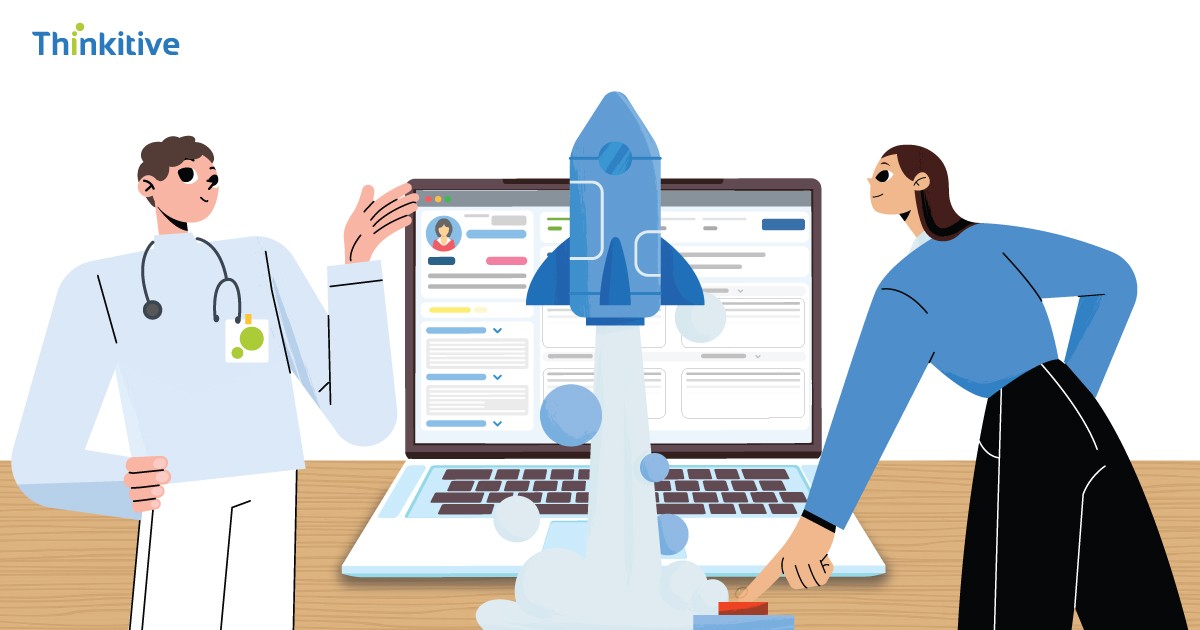Electronic Health Records (EHR) have made healthcare delivery easier and sophisticated. From allowing better patient data management practices in healthcare settings to allowing providers to make informed data-based decisions, custom EHR systems enhanced the quality of care.
With the widespread adoption of the EHR system, a specific niche for EHR software development specific to a practice has gained attention. Since every healthcare practice has a unique way of functioning and clinical workflow, developing a custom EHR system specific to practice is becoming a norm with each passing day.
However, the challenges of building a custom EHR system specific to a practice is putting healthcare providers in a dilemma, whether to make the transition to custom EHR system or to continue with a generic off-the-shelf EHR software system.
The benefits of a custom EHR system has surpassed the challenges of building a custom EHR system. Furthermore, the development process is quite long and finding a reliable EHR development partner has become a necessity lately.
Let’s help you understand the development process for a custom EHR system and try to find the answer to how to find a reliable EHR development partner.
So, without further ado, let’s get started!

Conducting a Comprehensive Needs Assessment
— Identifying Practice Requirements
The first and foremost thing that comes into the picture when building a custom EHR system is to understand what role the EHR software is going to play in your practice. The EHR software development process needs to be aligned with the clinical workflow since it aims to make the work easier and not complicated and manual.
When you make sure you and the custom EHR development vendor sits together and work to understand the specific needs of the clinic and also the workflow. For instance, if you’re developing a custom EHR system for orthopedic, then the role of medical images and scans have to play an important role. The clinical workflow should consider integration with other healthcare providers for the smooth flow or delivery and uninterrupted delivery of care.
— Involve Key Stakeholders
One of the best practices for custom EHR development is to involve the key stakeholders in the initial stages of the process. Stakeholders usually include everyone involved in the care delivery process, from doctors, nurses, administrative staff, and IT personnel. Assess their unique needs, and since they have to work in sync for seamless delivery, the software can bridge that gap. This will not only ensure that the system meets the practical needs of the practices but also address the necessary gaps that might arise later in the last stages of software development.
— Set Clear Goals and Objectives
During the first stage of development, clear goals and objectives for the practice should be set for what the practice wants to achieve with the custom EHR system development. The goals can be about enhancing care delivery, improving patient engagement or even automating manual tasks to streamline data. These EHR goals need to be aligned with overall practice objectives as it will be implemented in the entire practice.
Selecting the Right Development Partner
All the challenges of building a custom EHR system will be a walk in the park if you know how to find a reliable EHR development partner. Let’s see exactly that below:
— Evaluating Experience and Expertise
When you look for selecting a custom EHR development partner or vendor, they must be evaluated on the criteria of evaluation, experience and expertise. This will not only give you a brief understanding of the cost of developing a custom EHR system.
With experience comes expertise which can define the shape of your practice and pave the way for the future of your practice. Technical expertise is important in EHR software development as you have to follow a number of necessary compliances and regulations to safeguard your patients information.
— Review Portfolio and References
Ask for the vendor’s portfolio on the project’s they have worked and delivered before. By asking the right questions, try to get the projects that are similar to your project. This will help you in evaluating the expertise level of the vendor when developing a project for the healthcare industry. Along with that, when asking for the portfolio, also ask for the clients that are currently working for this.
When cross checking the references, contact the previous clients and try to understand what it is like working with the EHR development vendor. Also, check the quality and functionality of the features that you want in your software, this will help you in assessing the quality of the project being delivered.
— Ensuring Cultural Fit and Communication
Last but not least, ensure that the EHR vendor is right to work with and would ideally fit in your workplace culture. Also, the quality to value in custom EHR systems development is effective communication. Effective communication is the key to developing the project the way you want it. Also, some things that you need to check for are the project management styles, as it can help in understanding what aspect of the software is going to be developed first.
Designing the System
The next step in the development stage is designing the system and making it for practice.
— Creating a Detailed Project Plan
The first step in designing the system is to create a comprehensive project plan which will include milestones for developing each aspect of the system and timeline to achieve that. Discuss the strategy that will be followed in developing the system and also clarify if there are any changes in the system then how it will be addressed and implemented.
Below are some key elements that you must emphasize while developing a robust custom EHR system:
— User-Centered Design Approach
Emphasis on having a user-centric design approach to ensure usability and satisfaction. Since most of the healthcare providers and patients are already struggling with their health and busy scheduling, the difficulty in using the software can cause delays in the project and cause frustrations.
Along involve some of the stakeholders who will be using the software to take their input and make sure it is implemented, after all they are the people who will be using the software.
— Prototyping and Feedback
As each and every aspect of the custom EHR system is being developed, ensure to check that by asking for a prototype. It will be a demo version of a small aspect of the entire custom EHR system, but it can help visualize the final product. Furthermore, this way, it is also easier to find any issues and get them solved effectively before deploying the project.
Development and Testing
The software enters the next stage, development. Let’s examine what you need to do in this stage.
— Iterative Development Process
Have a brief understanding of the development process and what are the different stages of development. Usually, these development stages are classified into two categories: waterfall and agile. Discuss both methodologies with the IT development partner and choose the one that suits you the best.
Given the quite fluctuating nature of the healthcare IT industry, choose the development methodology that offers more flexibility and agility, which allows continuous integration and delivery so that the software is robust and meets all the necessary requirements.
—Quality Assurance and Testing
After development, rigorously test the software under different conditions and situations to identify issues with the system and fix them as early as possible to ensure timely delivery of the software. Furthermore, different testing methods are used in the process, such as unit testing, user acceptance testing, etc. Ensure that the software passes all the different testing methodologies; this way, you can ensure the software development is robust and does work under extreme conditions.
— Incorporating User Feedback
The users developing the software will know the intricacies of developing the software but not the user. That is why it is so crucial to incorporate user-feedback during the development phase. This will help you in developing a user-centric custom EHR system which elevates the overall user experience and satisfaction levels. Furthermore, following this feedback mechanism can lead to a better product with continuous improvement.
Implementation and Training
— Data Migration and System Integration
As soon as the custom EHR system enters the deployment phase data migration is the first challenge that it faces. Discuss and know the challenges that might appear in this process and how the data will be migrated from existing systems to the new custom EHR system.
The most important role is played by seamless integrations which will ensure smoother operations and working of the system in the new ecosystem.
— Staff Training Programs
Once the EHR software development process is complete, you need to implement a robust staff training program as they will be the one using the program. With comprehensive training, tailored to different user groups, you can ensure that everyone who will be using the custom EHR system will know its functionalities inside out and will result in better performance and enhanced care delivery.
— Go-live Preparation and Support
When the software is finally ready for deployment, prepare for it by keeping a support team in place, just in case the software system doesn’t work properly. Apart from that, follow the best practices, and start by conducting a co-pilot launch with a limited group. This will help you in identifying the existing problems and issues in the system before it makes it to final go.
Post-launch Support and Continuous Improvement
Once the custom EHR system is deployed, continuous support and continuous improvement are required. Here are some major things that you should consider.
— Ongoing Technical Support
As soon as the data starts flowing from the new custom EHR system and it starts functioning, there is a chance that any bugs or issues might appear in some functionality that might disrupt or cause delays in care delivery. That is why ongoing technical support is required to address such issues in real-time and ensure smoother operations.
— Regular Updates and Upgrades
As newer technologies come into the picture, the system needs to update itself to handle a higher amount of data or load. Along with that, due to the evolving nature of the healthcare compliances and laws, it becomes easier to comply with them with regular updates and upgrades that are required in the system.
— Feedback and Optimization
Just the feedback mechanism implemented during the development stage, you should also implement one in the new custom EHR system. This way, it becomes easier for the end-user to know and report any problem and for the development team to address and take necessary action to enhance the user experience.
Conclusion
The custom EHR development process is complicated and involves various stages that require attention. That is why investing time and resources in the EHR software development process is so important. On that note, let this blog be your guide to know the inside out of the custom EHR system development process.
Frequently Asked Questions
1. Why is a needs assessment important in EHR development?
A needs assessment in EHR development is crucial like planning a trip. It identifies the specific needs of users and the healthcare facility. This ensures the EHR fits their workflow, supports their goals, and avoids investing in features that aren’t relevant. By understanding the destination (user needs) before development, you create a more efficient and successful EHR system.
2. What criteria should we consider when selecting an EHR vendor?
Choosing an EHR vendor involves balancing features, budget, and fit:
- Define your must-have features and budget.
- Consider if a cloud-based or on-site system suits you better. Research vendors, compare features, and shortlist those that align with your needs.
- References should be checked, and the vendor’s implementation support and training should be assessed.
3. What are the benefits of a custom EHR system over off-the-shelf solutions?
Custom EHRs can be built exactly for your workflow, boosting efficiency and staff satisfaction. They integrate seamlessly with your existing tools and specialize in your area of medicine, offering features off-the-shelf solutions you might lack. However, the cost and development time are significantly higher.
4. How can we ensure a smooth transition to a new EHR system?
A successful EHR switch hinges on planning. Start by involving all staff in choosing a system that aligns with workflows. Thorough training for everyone ensures smooth use. Plan data migration carefully to safeguard patient information. Finally, anticipate a learning curve and allow for support during the initial switch.
5. What should we do if we encounter issues after the EHR system launch?
Absolutely, document any issues encountered with the EHR system after launch. Report them to the IT support team assigned to the project. They will be able to troubleshoot and resolve the problems you experience. This will help ensure a smooth transition to the new system.
6. How much does it cost to build a custom EHR system?
The cost of building a custom EHR system can vary greatly depending on complexity, size, and features. A basic system might cost $50,000-$100,000, while a comprehensive system for a large hospital could cost millions.
7. How long does it take to develop a custom EHR system?
Developing a custom EHR system can take anywhere from a few months to several years. The timeline depends on factors like complexity, features, and team size. A basic system with a small team might be built in months, while a complex system with a large team could take years.
8. What are the benefits of a custom EHR system compared to off-the-shelf solutions?
Custom EHRs tailor workflows to your specific practice, boosting efficiency and care. Imagine a system built for your specialty, seamlessly integrated with your devices, prioritizing security and exactly what your doctors need – all for potentially better patient outcomes. While upfront costs are higher, long-term gains can outweigh them.
9. Is it secure to build a custom EHR system?
Building a secure custom EHR system is possible, but it’s a high hurdle. You’ll need expert developers familiar with HIPAA compliance and strong security practices. Existing EHRs benefit from ongoing security updates and a large user base for testing. Carefully weigh the risks and resources needed before building your own.
⸻ Author Bio ⸻

Akash Hekare — Lead Software Engineer at Thinkitive Technologies












